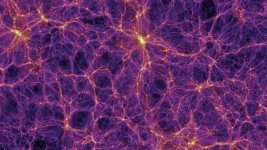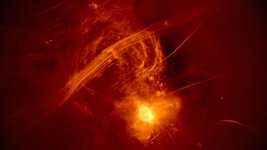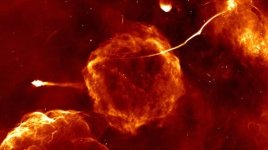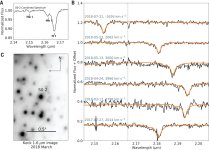I always wish they gave more info on wavelength and what the view means. The type I was looking for was much earlier work.MeerKAT array
They provide a background intro on how MeerKAT works
https://docs.google.com/presentation/d/1ITJmCUqgxGtCiEs5RadDYw7RA1Fk-5K2BI_d25wv9Cw/edit#slide=id.p1
There are presentations as well but audio etc nvg
For more detail they point at this book What is radio astronomy is an easy read.
https://www.cv.nrao.edu/~sransom/web/xxx.html
Indirectly it shows the curve fitting of the CMB, Not seen that before.
Now, Dave's cosmic web image is an "artist's impression" (or "model" as it states in the link) - not to be confused with an "observation".
Here's another artist's impression: https://www.esa.int/ESA_Multimedia/Images/2020/03/The_cosmic_web_artist_s_impression
Here's another artist's impression: https://www.esa.int/ESA_Multimedia/Images/2020/03/The_cosmic_web_artist_s_impression
a background intro on how MeerKAT works
The MeerKAT array consists of 64 individual dish telescopes, each of which collects and focuses radio signals.
There is a time difference in the radio signal arriving at each dish in the array which produces phase delays. As the Earth turns, the dish telescopes tilt to keep watching the radio source and this causes the phase delays to change.
The more phase variations we get, the more perspectives we have on the object being observed, which leads to greater resolution in the image.
That's all assisted by massive data processing of course!
A full description of how arrays such as meerKAT work can be found within this link: https://public.nrao.edu/telescopes/radio-telescopes/
An interesting comment from NASA
A Common MisconceptionBlack holes cannot suck matter into them except under certain conditions. If the sun instantly turned into a black hole, Earth and even Mercury would continue to orbit the new object and not fall in. There are two common cases in the universe in which matter can be dragged into a black hole. Case 1: If a body orbits close to the event horizon in an elliptical orbit, it emits gravitational radiation, and its orbit will eventually decay in millions of years. Case 2: A disk of gas can form around a black hole, and through friction, matter will slowly slide into the black hole over time.
Not obvious but understandable. Good read, 😉 might help cumbb
https://www.nasa.gov/sites/default/files/atoms/files/black_hole_math.pdf
It gives a brief introduction to n dimensional maths. Pythagoras for instance. The aether was initially disproved via cumbb like thoughts - people could pick it up and compress it. Einstein is much the same - you can't but the effects can be show pictorially. Crumbb wants to see it bent - no chance.
The comment -Eeeek, they point out mass is lost and emitted as energy
A Common MisconceptionBlack holes cannot suck matter into them except under certain conditions. If the sun instantly turned into a black hole, Earth and even Mercury would continue to orbit the new object and not fall in. There are two common cases in the universe in which matter can be dragged into a black hole. Case 1: If a body orbits close to the event horizon in an elliptical orbit, it emits gravitational radiation, and its orbit will eventually decay in millions of years. Case 2: A disk of gas can form around a black hole, and through friction, matter will slowly slide into the black hole over time.
Not obvious but understandable. Good read, 😉 might help cumbb
https://www.nasa.gov/sites/default/files/atoms/files/black_hole_math.pdf
It gives a brief introduction to n dimensional maths. Pythagoras for instance. The aether was initially disproved via cumbb like thoughts - people could pick it up and compress it. Einstein is much the same - you can't but the effects can be show pictorially. Crumbb wants to see it bent - no chance.
The comment -Eeeek, they point out mass is lost and emitted as energy
An interesting comment from NASA
They provide a good summary, which is in accord with what I've always perceived the situation to be.
Earlier, I mentioned star S-02 which hurtles around Sgr A* in its highly elliptical, 16 year orbit.
Its ultimate fate will be to spiral to its destruction in the heart of the supermassive black hole, something which won't happen in our lifetime.
;-?An interesting comment from NASA
... gravitational radiation
;-?... disk of gas can form around a black hole, and through friction, matter will slowly slide into the black hole over time.
Besides all the nonsense that NASA can shove into you about black holes - obviously you don't even understand Einsteins RT -:
What NASA does not tell you:
Quasars playground;-)
First the observation, then the reveries, then the "mathematics"-)
Another interesting fact about star S-02 (sometimes called S2) is that has the fastest ballistic orbit yet measured, travelling at almost 3% of the speed of light at its closest approach to Sgr A*.

One of the predictions of Einstein's general theory of relativity is that light will lose energy as it struggles to move through an intense gravitational field.
When S-02 is at its closest approach to Sgr A*, its light slows down. This shows up as a stretching of the star's light toward the less energetic, longer wavelengths.
Gravitational red shifts are well known, but S-02 provided the first direct test of how gravity works near a supermassive black hole. The astronomers have measured that the light from the star slows down by 125 miles per second, which is exactly as predicted by Einstein's theory of general relativity.
The spectral analysis showing the shift in the H 1 line towards the longer wavelengths is shown in the attachment
One of the predictions of Einstein's general theory of relativity is that light will lose energy as it struggles to move through an intense gravitational field.
When S-02 is at its closest approach to Sgr A*, its light slows down. This shows up as a stretching of the star's light toward the less energetic, longer wavelengths.
Gravitational red shifts are well known, but S-02 provided the first direct test of how gravity works near a supermassive black hole. The astronomers have measured that the light from the star slows down by 125 miles per second, which is exactly as predicted by Einstein's theory of general relativity.
The spectral analysis showing the shift in the H 1 line towards the longer wavelengths is shown in the attachment
Attachments
That suggests the gravitational field they are orbiting in hasn't changed.😱 but they also mention some mass loss as the black hole is formed also I assume in the case of a novaIf the sun instantly turned into a black hole, Earth and even Mercury would continue to orbit the new object and not fall in.
The Sun's gravity is equivalent to that of a black hole with an event horizon radius of about 3 km.
There would be no change in Mercury's or Earth's orbit if the Sun were to magically transform itself into a black hole.
Of course, the Sun can not turn into a black hole.
Being an average star it will evolve into a red giant, eject a beautiful nebula and end up as a white dwarf.

There would be no change in Mercury's or Earth's orbit if the Sun were to magically transform itself into a black hole.
Of course, the Sun can not turn into a black hole.
Being an average star it will evolve into a red giant, eject a beautiful nebula and end up as a white dwarf.
The follow on videoQuasars playground;-)
Arp with similar views. Hoyle went away and wrote books.
Your video mention why people don't believe him. We haven't been studying long enough to know that he isn't correct and he make a fair point about specialism and resistance to different ideas.
Some of these people would love this
Data from the Planck Mission shows hemispheric bias in the cosmic microwave background (CMB) in two respects: one with respect to average temperature (i.e. temperature fluctuations), the second with respect to larger variations in the degree of perturbations (i.e. densities). The European Space Agency (the governing body of the Planck Mission) has concluded that these anisotropies in the CMB are, in fact, statistically significant and can no longer be ignored.
;-)The Sun's gravity is equivalent to that of a black hole with an event horizon radius of about 3 km.
There would be no change in Mercury's or Earth's orbit if the Sun were to magically transform itself into a black hole.
Of course, the Sun can not turn into a black hole.
Being an average star it will evolve into a red giant, eject a beautiful nebula and end up as a white dwarf.
View attachment 1191744
"Nebulae" remind of plasma, somehow;-)
https://en.wikipedia.org/wiki/Plasma_(physics)
Not "gravitational-lensing" but "light refraction, -redirection".
Oxymoron? Gravitational lensing causes light refraction, and redirection.
dave
Some of these people would love this... The European Space Agency (the governing body of the Planck Mission) has concluded that these anisotropies in the CMB are, in fact, statistically significant and can no longer be ignored.
The results from the final full-mission Planck measurements of the CMB anisotropies show good consistency with the standard Lambda-CDM cosmology and no compelling evidence for extensions to the base model has been found.
Above, the anisotropies of the cosmic microwave background based on data from the Planck mission’s final data release, published in July 2018.
I absolutely agree, though these webpages are made for the general public who tends to be averse to numbers. The place to find this would be scientific and technical publications, which are harder to find and too often behind paywalls.I always wish they gave more info on wavelength and what the view means.
"Radio Waves" covers a large range of frequencies (or equivalently, wavelengths). This transmitter and transmitting antenna system, designed to signal submarines when under water, goes down to 30Hz:
https://pages.hep.wisc.edu/~prepost/ELF.pdf
I recall microwaves go to 30gHz, 10^9 times that 30Hz frequency. That's quite the range ...
Actually, googling microwave frequency range shows two answers:
"Microwave frequencies range between 109 Hz (1 GHz) to 1000 GHz with respective wavelengths of 30 to 0.03 cm."
"Microwave frequency range spans from ~300 MHz to 30 GHz (3 x 106 HZ – 30 x 109 Hz) corresponding to a wavelength range of 1 m to 0.01 …"
... so by the first definition, the range for "radio frequency" is over 10^10.
I was thinking radio astronomy was all in the microwave range above 1GHz, but there are allocations for it throughout the radio bands:
https://en.wikipedia.org/wiki/Radio_astronomy#Frequency_allocation
The visible spectrum, OTOH, only goes over a relatively narrow 2-to-1 range.
Oxymoron?
Oxy-
A combining form meaning "sharp" used in the formation of compound words.
I absolutely agree, though these webpages are made for the general public who tends to be averse to numbers. The place to find this would be scientific and technical publications, which are harder to find and too often behind paywalls.
Some simple information relating to radio wavelengths:
"These specially-designed [radio] telescopes observe the longest wavelengths of light, ranging from 1 millimeter to over 10 meters long. For comparison, visible light waves are only a few hundred nanometers long, and a nanometer is only 1/10,000th the thickness of a piece of paper! In fact, we don’t usually refer to radio light by its wavelength, but by its frequency."
Go tell them that then.no compelling evidence for extensions to the base model has been found.
- Home
- Member Areas
- The Lounge
- Does this explain what generates gravity?



